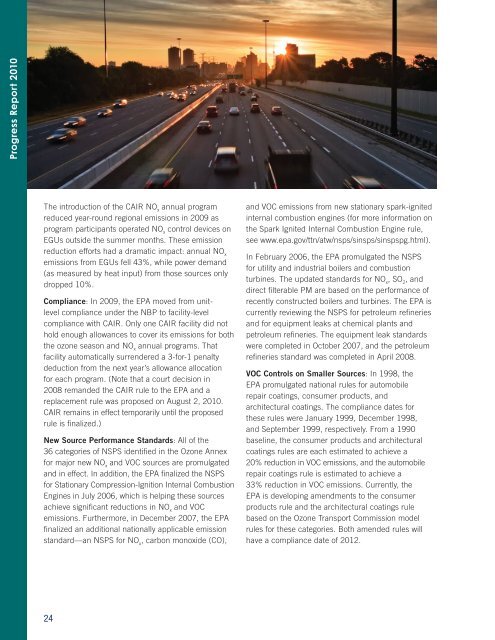2010 Progress Report - International Joint Commission
2010 Progress Report - International Joint Commission
2010 Progress Report - International Joint Commission
You also want an ePaper? Increase the reach of your titles
YUMPU automatically turns print PDFs into web optimized ePapers that Google loves.
<strong>Progress</strong> <strong>Report</strong> <strong>2010</strong><br />
The introduction of the CAIR NO x<br />
annual program<br />
reduced year-round regional emissions in 2009 as<br />
program participants operated NO x<br />
control devices on<br />
EGUs outside the summer months. These emission<br />
reduction efforts had a dramatic impact: annual NO x<br />
emissions from EGUs fell 43%, while power demand<br />
(as measured by heat input) from those sources only<br />
dropped 10%.<br />
Compliance: In 2009, the EPA moved from unitlevel<br />
compliance under the NBP to facility-level<br />
compliance with CAIR. Only one CAIR facility did not<br />
hold enough allowances to cover its emissions for both<br />
the ozone season and NO x<br />
annual programs. That<br />
facility automatically surrendered a 3-for-1 penalty<br />
deduction from the next year’s allowance allocation<br />
for each program. (Note that a court decision in<br />
2008 remanded the CAIR rule to the EPA and a<br />
replacement rule was proposed on August 2, <strong>2010</strong>.<br />
CAIR remains in effect temporarily until the proposed<br />
rule is fi nalized.)<br />
New Source Performance Standards: All of the<br />
36 categories of NSPS identifi ed in the Ozone Annex<br />
for major new NO x<br />
and VOC sources are promulgated<br />
and in effect. In addition, the EPA fi nalized the NSPS<br />
for Stationary Compression-Ignition Internal Combustion<br />
Engines in July 2006, which is helping these sources<br />
achieve signifi cant reductions in NO x<br />
and VOC<br />
emissions. Furthermore, in December 2007, the EPA<br />
fi nalized an additional nationally applicable emission<br />
standard—an NSPS for NO x<br />
, carbon monoxide (CO),<br />
and VOC emissions from new stationary spark-ignited<br />
internal combustion engines (for more information on<br />
the Spark Ignited Internal Combustion Engine rule,<br />
see www.epa.gov/ttn/atw/nsps/sinsps/sinspspg.html).<br />
In February 2006, the EPA promulgated the NSPS<br />
for utility and industrial boilers and combustion<br />
turbines. The updated standards for NO x<br />
, SO 2<br />
, and<br />
direct fi lterable PM are based on the performance of<br />
recently constructed boilers and turbines. The EPA is<br />
currently reviewing the NSPS for petroleum refi neries<br />
and for equipment leaks at chemical plants and<br />
petroleum refi neries. The equipment leak standards<br />
were completed in October 2007, and the petroleum<br />
refi neries standard was completed in April 2008.<br />
VOC Controls on Smaller Sources: In 1998, the<br />
EPA promulgated national rules for automobile<br />
repair coatings, consumer products, and<br />
architectural coatings. The compliance dates for<br />
these rules were January 1999, December 1998,<br />
and September 1999, respectively. From a 1990<br />
baseline, the consumer products and architectural<br />
coatings rules are each estimated to achieve a<br />
20% reduction in VOC emissions, and the automobile<br />
repair coatings rule is estimated to achieve a<br />
33% reduction in VOC emissions. Currently, the<br />
EPA is developing amendments to the consumer<br />
products rule and the architectural coatings rule<br />
based on the Ozone Transport <strong>Commission</strong> model<br />
rules for these categories. Both amended rules will<br />
have a compliance date of 2012.<br />
24
















